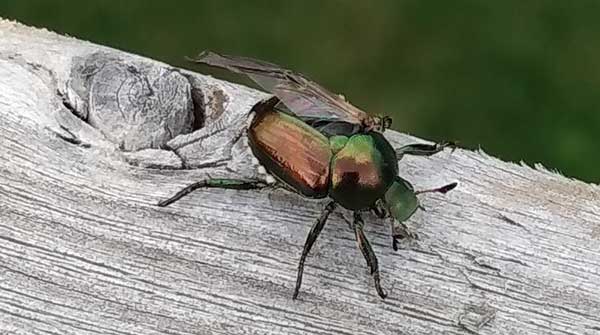First reported in the United States in 1916, the Japanese Beetle can now be found across North America
 Last year was an odd summer: so many insects appeared in perilously low numbers while others appeared in abundance. But why is it that the ones that cause the most damage or are the most annoying are the ones that seem to dominate the invertebrate landscape?
Last year was an odd summer: so many insects appeared in perilously low numbers while others appeared in abundance. But why is it that the ones that cause the most damage or are the most annoying are the ones that seem to dominate the invertebrate landscape?
Mosquitoes, blackflies, June bugs and others seem to come back every year in good numbers, but fireflies, Mayflies, and myriad others are present only in low numbers.
The answers will remain obscure, but resiliency and adaptability are assuredly part of the reason. Did you know that a mosquito egg can last up to seven years in the soil waiting for the right environmental conditions to hatch?
We are all too familiar with the devastation that the Emerald Ash Borer and the Spongy (formerly Gypsy) Moth cause. A new scourge visited last summer – the Japanese Beetle!
 |
| Related Stories |
| Where do fish go in the winter?
|
| Researcher assessing ripple effects of rodent disease
|
| Is nature really out to get us?
|
Now they may be annoying, but they are also very attractive. Related to Dung Beetles, each is about 15 mm (1/2 inch) long and sports iridescent colours that inspire awe. Greens and coppers dominate the back and head of this beetle, while five pairs of small white and two pairs of larger white dots can be found along the edges of the wings and abdomen.
First reported in North America in 1916 in the U.S., they spread slowly into Nova Scotia in 1939. From there, the rest is history: they can now be found across most of Canada and the U.S.
So let’s explore their life cycle a bit.
The female lays her eggs (40 to 60) in shallow soil singly or in small bunches that hatch in about two weeks and the larvae start feeding. They will go deeper into the soil for the winter, where they hibernate until the soil temperatures rise in the spring. Then the larvae (which look like tiny white grubs) burrow upward to shallower soil and continue feeding on grass and plant roots. After four to six weeks, they have grown substantially and enter their pupal stage, where they will transform into adult beetles.
While the larvae may do significant damage to turf, the adults are known to attack over 300 species of plants as they feed on the leaves and fruits of many species. They are known as skeletonizers, which simply means they feed on the soft tissue between the veins in the plant’s leaves. For the next four to six weeks, the beetles can be found in large numbers on favoured plant species.
They love our raspberries in my garden but ignore many others species that grow nearby, such as highbush cranberry and tomatoes. It is during this time that the females emit pheromones that drive the males crazy! They swarm to the females to copulate and then wait for another opportunity while snacking on our plants in the interim.
So what can you do? I don’t like broadcast pesticides and prefer to try to solve the problem in a more environmentally sensitive way. In my case, I only have a few (<100), so I pick them off individually and put them in a coffee jar for a bit, and after they’re ‘subdued,’ I put the carcasses in our small pond and the three small Painted Turtles that live there come to eat them for dinner. Seems like a win-win!
If you have a bigger issue or they are causing serious damage, several traps are available at local stores. These use artificial hormones to attract the males to the trap.
Recent research, however, indicates that these lures may, in fact, worsen the problem locally as the beetles come to the area in response to the bait but then stop short of entering the trap and feed on adjacent plants.
Even though this species is not native to North America, a disease called Milky Spore Disease has emerged that is fatal to them. Companion planting with repellant plants can be effective as well. Garlic, chives, tansy or catnip can provide some relief.
Nature is beautiful, but sometimes it can also be a bit annoying!
Geoff Carpentier is a published author, expedition guide and environmental consultant.
For interview requests, click here.
The opinions expressed by our columnists and contributors are theirs alone and do not inherently or expressly reflect the views of our publication.
© Troy Media
Troy Media is an editorial content provider to media outlets and its own hosted community news outlets across Canada.

